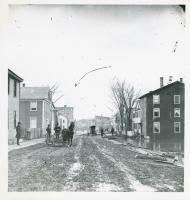Emily Albert, Brittany Briggs, Dakotah Knox & Nicole Walters
Hallowell’s waterfront has a rich history. There were vibrant neighborhoods, wharfs and even a ferry to Chelsea!

Hallowell viewed from Butternut Park, Chelsea, ca. 1890
Hubbard Free Library
In the early and middle 1800s. there were many shipbuilding spots on the shore of Kennebec River in Hallowell. Then in the 1900s, oil was brought to the waterfront in tanks. Later in the 1940s and 50s, the waterfront was used by people along Water Street and a lumber company. Shepard's Wharf was also on the waterfront and was the head of navigation for all large vessels. Mr. Page’s Ice House was also located on the waterfront for easy access to ice. When the railroad was built, the waterfront was used less. When the new Chelsea bridge was built, some big boats couldn't get through. So in time, the waterfront was used less and less. Now the waterfront is only used for recreational fun and pleasure.

Joppa Looking North, Hallowell, 1870
Courtesy of Sumner A. Webber, Sr., an individual partner
In the late 1880’s, Joppa was a waterfront section of Hallowell, Maine. The people that lived in Joppa were lower class and middle class. The people that lived by the water were lower class. The captains of the ships were middle class, and they lived higher on the hill. Joppa ran from Temple St. to the Vaughan Stream.